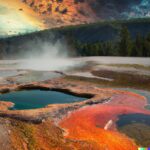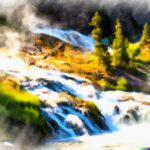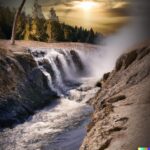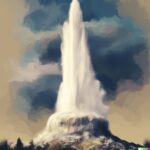Are you planning a trip to Yellowstone National Park and wondering what all the hype is about the geysers? In this article, we will explore what Yellowstone geysers are, why you should make them a must-see on your itinerary, and the best times to visit. We will also highlight some of the top geysers you won’t want to miss, along with practical tips for a safe and enjoyable visit. So, grab your camera and hiking boots as we take you on a journey to the mesmerizing world of Yellowstone geysers!
What Are Yellowstone Geysers?
Yellowstone Geysers are natural geothermal features found in Yellowstone National Park, showcasing a mesmerizing display of underground thermal activity.
These hydrothermal wonders play a crucial role in the park’s ecosystem, providing habitats for unique microorganisms that thrive in extreme environments. The geysers are a result of the water being heated deep within the Earth’s crust, creating immense pressure that eventually erupts in spectacular displays of boiling water and steam. The geology behind these features involves the presence of underground reservoirs of hot water that periodically find their way to the surface through vents, resulting in the iconic eruptions that captivate visitors from around the world.
Why Should You Visit Yellowstone Geysers?
Visiting Yellowstone Geysers offers a remarkable opportunity to witness some of nature’s most stunning spectacles, explore the park’s rich history, and immerse yourself in diverse ecosystems.
- As you traverse the boardwalks meandering through the geothermal wonders, you’ll marvel at the erupting geysers, such as the iconic Old Faithful, which punctuates the landscape with its remarkable displays.
- The park’s geological formations, from colorful hot springs to bubbling mud pots, provide a captivating glimpse into the Earth’s inner workings. Hiking trails wind through valleys and forests, leading you to breathtaking waterfalls and panoramic viewpoints that showcase the park’s unrivaled beauty.
- Wildlife sightings, from bison grazing in meadows to elusive wolves prowling in the wilderness, add an element of adventure to your Yellowstone experience.
What Are the Best Times to Visit Yellowstone Geysers?
Choosing the best time to visit Yellowstone Geysers depends on various factors such as weather conditions, wildlife sightings, and the park’s commitment to conservation and geysers maintenance.
Yellowstone National Park experiences distinct seasonal variations that impact the geyser viewing experience. During the summer months, when the weather is generally warmer and drier, visitors have more opportunities to witness the geysers’ impressive eruptions in clear skies. This season also presents ideal conditions for observing the park’s diverse wildlife, including bison, elk, and bears, making it a fantastic choice for those interested in wildlife watching. The peak season can also bring larger crowds, prompting the importance of practicing sustainable tourism to minimize environmental impact on the delicate ecosystem. Conservation efforts play a crucial role in ensuring the long-term sustainability of the geysers and wildlife habitats, underscoring the need for responsible visitor behavior and park management practices.
The shoulder seasons of spring and fall offer a more tranquil experience with fewer visitors, showcasing the park’s natural beauty in a quieter setting. Exploring the geysers during these times can offer a unique perspective, allowing for a more intimate connection with the geological wonders. It’s essential for visitors to be mindful of their impact on the environment and to support conservation initiatives that protect the geysers and the surrounding ecosystem. By being aware of the seasonal variations and practicing sustainable tourism, visitors can contribute to the preservation of Yellowstone’s natural splendor for future generations.
What Are the Peak Seasons for Yellowstone Geysers?
Peak seasons for visiting Yellowstone Geysers coincide with periods of increased wildlife activity, optimal weather conditions, and educational programs that delve into the geothermal energy beneath Earth’s crust.
During these bustling times, the sight of bison herds roaming freely across the vast landscapes is a common occurrence, adding a sense of raw wilderness to the visitor experience. The allure of the geysers is heightened by the vivid colors and bubbling hot springs, offering a truly mesmerizing display of nature’s power.
Visitors also have the opportunity to participate in educational programs that shed light on the unique geothermal energy sources present in the park, learning about their importance and sustainable use.
What Are the Off-peak Seasons for Yellowstone Geysers?
Off-peak seasons at Yellowstone Geysers offer a more serene experience with fewer crowds, ideal for camping enthusiasts, photography aficionados, and those interested in studying the park’s diverse rock layers and hydrogeological features.
During these quieter times, camping sites within the park provide an authentic and immersive way to connect with nature, surrounded by the remarkable geothermal features. Photography enthusiasts will find the soft lighting and lesser foot traffic conducive to capturing stunning shots of the geysers and wildlife. Exploring the distinct rock layers and understanding the park’s hydrogeology becomes even more captivating when you can observe and appreciate these natural wonders without the hustle and bustle of peak tourist seasons.
What Are the Must-see Geysers in Yellowstone?
Exploring Yellowstone Geysers would be incomplete without witnessing iconic geysers like Old Faithful, Grand Geyser, and Castle Geyser, each offering a glimpse into the park’s fascinating geothermal anomalies and geological surveys.
Among these, Old Faithful stands out not only for its predictable eruptions but also for its connection to the Yellowstone Caldera, a massive volcanic system that fuels the park’s geothermal features. Grand Geyser, known for its majestic eruptions, showcases the power beneath the Earth’s surface, while Castle Geyser impresses visitors with its unique cone structure and intermittently active nature. Each of these geysers provides a window into the complex geological processes at play within Yellowstone National Park.
Old Faithful Geyser
Old Faithful Geyser, renowned for its predictable eruptions, offers a fascinating look into the subsurface processes, geothermal monitoring, and the volcanic activity that has shaped the region over geological time.
Erupting roughly every 90 minutes, Old Faithful showcases the intricate balance of pressure and heat beneath the Earth’s surface. The geyser’s eruptions are fueled by superheated water rising from deep within the Earth, creating a captivating display of nature’s power.
Geothermal anomalies like these provide valuable insights into the activity of volcanic systems and highlight the importance of continuous monitoring to understand any potential shifts in the geothermal dynamics. Through monitoring tools and techniques, scientists can track changes in temperature, pressure, and gas emissions, aiding in predicting volcanic eruptions and safeguarding surrounding communities.
Grand Geyser
Grand Geyser’s majestic eruptions showcase the dynamics of hydrothermal circulation, the impact of crustal movements, and the geothermic wonders that underscore Yellowstone’s unique thermal activity near the supervolcano.
The Grand Geyser, with its breathtaking eruptions, is a prime example of the intricate interaction between water and heat underneath the Earth’s surface. As water seeps deep into the crust, it is heated by the immense geothermal energy that lies beneath Yellowstone’s rugged terrain. This process creates immense pressure, eventually leading to the awe-inspiring eruptions that can reach heights of over 200 feet. These eruptions not only mesmerize onlookers but also play a crucial role in releasing pressure caused by the supervolcano’s immense geothermal energy, thereby helping to regulate the park’s thermal features.
Riverside Geyser
Riverside Geyser’s displays reveal insights into the underlying magma chambers, the behavior of geysers, and the importance of sustainable practices in preserving the park’s unique geologic formations and geothermal system.
These characteristics of Riverside Geyser offer a fascinating glimpse into how the Earth’s natural forces interact to create such awe-inspiring spectacles. The presence of magma chambers beneath the geyser plays a crucial role in fueling its eruptions, generating the heat and pressure necessary for the steaming water to erupt with remarkable force. Understanding the behavior of geysers like Riverside Geyser opens doors to unraveling the mysteries of our planet’s geothermal activity and the delicate balance required for sustaining these geological wonders. Implementing sustainable practices is imperative not only in safeguarding the park’s geological diversity but also in protecting the fragile ecosystem supported by the geothermal system.”
Castle Geyser
Castle Geyser’s eruptions highlight the intense steam pressure, geological impacts on Earth’s crust, and the importance of geysers maintenance for preserving the region’s rock layers and harnessing geothermal energy.
The extreme pressure created by the boiling water beneath the surface is what propels Castle Geyser’s spectacular eruptions, sending water and steam soaring into the sky. These eruptions not only showcase the power of nature but also play a crucial role in the natural maintenance of the geyser itself. By releasing built-up pressure deep within the Earth’s crust, geysers like Castle Geyser help to prevent potential catastrophic events like volcanic eruptions by allowing the earth’s energy to escape in a controlled manner.
Great Fountain Geyser
Great Fountain Geyser’s bubbling mud pots offer a glimpse into the underlying plate tectonics, highlighting the importance of environmental stewardship and the breathtaking scenic views surrounding the park’s caldera.
As visitors explore the park, they witness the dynamic relation between the Earth’s crustal movements and the stunning landscapes. The interconnectedness of the park’s unique geological features and the fragile ecosystem emphasizes the need for conservation efforts.
Yellowstone National Park, where this majestic geyser resides, has been at the forefront of environmental stewardship, implementing sustainable practices to preserve its natural wonders for future generations. The geyser’s eruptions, fueled by the underlying geological activity, serve as a reminder of the powerful forces constantly shaping the Earth’s surface.
What Are Some Tips for Visiting Yellowstone Geysers?
Planning a trip to Yellowstone Geysers requires adherence to safety precautions, awareness of park regulations, and packing essentials while exploring the array of family-friendly activities under the guidance of a comprehensive travel guide.
When embarking on your adventure at Yellowstone Geysers, remember to always stay on designated trails to protect both yourself and the delicate ecosystem. Make sure to carry sufficient water, snacks, and sun protection in your daypack, as the geothermal features can be deceptively draining.
For families, joining ranger-led programs is a fantastic way to learn about the park’s geology and wildlife while engaging the kids. Ensure you have sturdy footwear to navigate the sometimes uneven terrain, and don’t forget a camera to capture the stunning geysers in their full glory!
Best Ways to Get to Yellowstone Geysers
Embarking on a road trip to Yellowstone Geysers provides an ideal opportunity for immersive experiences, ranger talks, and discovering the diverse insect species that contribute to the park’s rich geologic time and geothermal anomalies.
Engaging with knowledgeable park rangers during their informative talks allows for a deeper understanding of the geological context behind the impressive geothermal anomalies scattered throughout the park.
Exploring the insect species unique to this environment gives visitors a glimpse into the intricate web of life that thrives in Yellowstone’s diverse ecosystems, showcasing the interconnectedness between these tiny creatures and the park’s awe-inspiring landscapes.
The road trip experience offers a chance to appreciate the natural wonders of Yellowstone in a more intimate and enriching way, immersing oneself in a world shaped by ancient geological forces and teeming with fascinating biodiversity.
What to Bring and Wear for Your Visit?
Ensuring a comfortable and safe visit to Yellowstone Geysers involves packing essentials like bear safety gear, clothes suitable for maintaining ecological balance, and items for observing the diverse flora and fauna flourishing near the supervolcano.
- This pristine ecosystem demands adherence to bear safety precautions, as encounters with these magnificent creatures are a possibility.
- Opt for colorful clothing with natural tones to blend with the surroundings, enhancing the chances of glimpsing elk, bison, and other wildlife.
Be sure to bring binoculars or a camera to capture the beauty of the diverse plant life, including vibrant wildflowers and towering trees. By respecting the delicate balance of nature in this geothermal wonderland, visitors can immerse themselves in a truly enriching experience.
How to Stay Safe While Visiting Yellowstone Geysers?
Prioritizing safety while exploring Yellowstone Geysers involves awareness of bear safety protocols, precautions against encountering wolf packs, and understanding the geological features such as sedimentary rocks within the park’s dynamic geothermal system.
Visitors should always remember to make noise while hiking to avoid surprising bears. Being equipped with bear spray and knowing how to respond calmly in a bear encounter is crucial. Understanding wolf behavior can help minimize potential risks; never approach or feed them.
Yellowstone’s geysers are a result of its unique geothermal activity, showcasing vibrant colors due to various minerals in the water. The park’s sedimentary rocks, formed over millions of years, offer a window into Earth’s history and contribute to its breathtaking landscape.
What Other Activities Can You Do While Visiting Yellowstone Geysers?
Apart from geyser viewing, visitors to Yellowstone Geysers can enjoy a range of family-friendly activities, wildlife watching opportunities, and educational programs on volcanic activity, earthquake patterns, and the harnessing of geothermal energy.
Families can embark on guided nature walks to spot bison, elk, and bears in their natural habitat, while birdwatchers can marvel at the diverse avian species soaring through the skies.
Educational programs delve into the fascinating world of geology and geothermal energy, offering insights into how nature’s forces shape the earth’s surface.
Visitors can also participate in hands-on demonstrations showcasing the utilization of geothermal energy for sustainable practices, highlighting the park’s commitment to environmental conservation and education.
Last Updated on February 7, 2024 by Jon Waraas – Originally Posted: February 7, 2024

I’m Jon Waraas, and I’ve been navigating the online world since 2006. By day, I’m the proud owner of some eCommerce gems, and by night, I’m the voice behind the adventures on Waraas.Com.
My heart, however, belongs to the wild beauty of Yellowstone National Park. I’ve got a collection of websites dedicated to sharing the wonders of this natural masterpiece. Oh, and did I mention? I’m currently building my own cabin inside the ghost town of Gilmore, Idaho – a cabin with tales to tell!
When I’m not immersed in the digital realm, you’ll find me lacing up my boots for a good hike or setting up camp under the star-studded sky.




